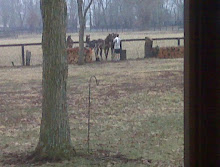
Still one of the most searched-for topics around, according to my website/blog keyword search statistics. Historically, many barns seem to experience shin problems in 2 year olds from 30-50% of the time, some operations these days tell me it's more like 10%.
Once again, I find the answer in exercise science and the concept of progressive overload. Simply put, legging up style long slow gallops build 'gallop' bone, while breezes at :15sec/furlong and faster build 'breeze' bone. If you immediately jump from 2 months of gallop that never got faster than :15sec/f directly to breezes in :13 or faster, you often run into trouble.
The above protocol from Dr. Jack Woolsey is his adaptation of the famous Maryland shin study of Dr. Nunamaker (of New Bolton Center fame) and trainer/vet Dr. Fisher (currently at Fair Hill I believe). These guys are sharp.
To pare down their research to the basics; they noticed that horses who only slow galloped failed to build strong bone density and were at increased risk for saucer fractures. But when 'speed' work was slowly and gradually introduced as stated above, not only did the shin problems disappear, but the 2 year olds developed the bone density of 4 year olds!
The key is to add speed very slowly - starting with a single :15 furlong at the end of 2 weekly gallops and progressing to a half mile breeze in :52 roughly 16 weeks later.
They also addressed the issue of frequency. Whenever the 'speed' work took place more than 5 days apart, the bone began to lose the remodelling effect. Now bone is by all accounts the slowest system of the horse to respond to training, but it still does so in less than 5 days if stimulated appropriately.
More ammunition to my belief that when you breeze horses every 6-10 days, you often lose much of the cumulative fitness effect in between works. If bone adapts and recovers every 4 days, how fast does the heart, lungs, suspensories, blood, enzymes, etc. recover? Within 2-3 days is a safe bet.
I could write 15 pages on this, and I have much more info from Drs. Nunamaker and Fisher, drop me a line if you would like to see it...




I would love to see the study. Enjoying the posts.
ReplyDeleteHere you go Wind-
ReplyDeletehttp://www.ivis.org/proceedings/aaep/2002/910102000076.PDF
Bill
This all makes total sense. Now, how do I get my trainers to do anything remotely like this, bearing in mind that the horses are stabled at the track and can't train anywhere other than on the dirt track every morning.
ReplyDeleteHi Steve-
ReplyDeleteRight now I've got my hands full working with trainers here in KY. To start the process requires me to be onsite quite often in the mornings.
In the next 2 weeks I'll be testing some new equipment that a trainer could use anywhere in the world to gather the data, send it to me, and I can manage the relationship remotely.
Shoot me an email to bill@thoroedge.com with regards to your situation and we can go over the details.